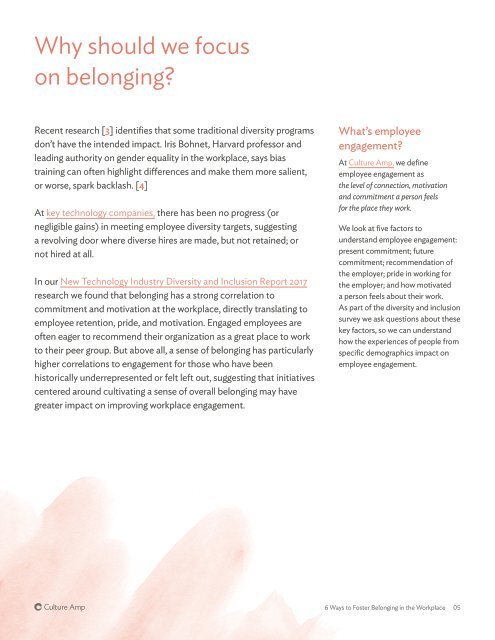in the Workplace
Culture-Amp_6-ways-to-foster-belonging
Culture-Amp_6-ways-to-foster-belonging
Create successful ePaper yourself
Turn your PDF publications into a flip-book with our unique Google optimized e-Paper software.
Why should we focus<br />
on belong<strong>in</strong>g?<br />
Recent research [3] identifies that some traditional diversity programs<br />
don’t have <strong>the</strong> <strong>in</strong>tended impact. Iris Bohnet, Harvard professor and<br />
lead<strong>in</strong>g authority on gender equality <strong>in</strong> <strong>the</strong> workplace, says bias<br />
tra<strong>in</strong><strong>in</strong>g can often highlight differences and make <strong>the</strong>m more salient,<br />
or worse, spark backlash. [4]<br />
At key technology companies, <strong>the</strong>re has been no progress (or<br />
negligible ga<strong>in</strong>s) <strong>in</strong> meet<strong>in</strong>g employee diversity targets, suggest<strong>in</strong>g<br />
a revolv<strong>in</strong>g door where diverse hires are made, but not reta<strong>in</strong>ed; or<br />
not hired at all.<br />
In our New Technology Industry Diversity and Inclusion Report 2017<br />
research we found that belong<strong>in</strong>g has a strong correlation to<br />
commitment and motivation at <strong>the</strong> workplace, directly translat<strong>in</strong>g to<br />
employee retention, pride, and motivation. Engaged employees are<br />
often eager to recommend <strong>the</strong>ir organization as a great place to work<br />
to <strong>the</strong>ir peer group. But above all, a sense of belong<strong>in</strong>g has particularly<br />
higher correlations to engagement for those who have been<br />
historically underrepresented or felt left out, suggest<strong>in</strong>g that <strong>in</strong>itiatives<br />
centered around cultivat<strong>in</strong>g a sense of overall belong<strong>in</strong>g may have<br />
greater impact on improv<strong>in</strong>g workplace engagement.<br />
What’s employee<br />
engagement?<br />
At Culture Amp, we def<strong>in</strong>e<br />
employee engagement as<br />
<strong>the</strong> level of connection, motivation<br />
and commitment a person feels<br />
for <strong>the</strong> place <strong>the</strong>y work.<br />
We look at five factors to<br />
understand employee engagement:<br />
present commitment; future<br />
commitment; recommendation of<br />
<strong>the</strong> employer; pride <strong>in</strong> work<strong>in</strong>g for<br />
<strong>the</strong> employer; and how motivated<br />
a person feels about <strong>the</strong>ir work.<br />
As part of <strong>the</strong> diversity and <strong>in</strong>clusion<br />
survey we ask questions about <strong>the</strong>se<br />
key factors, so we can understand<br />
how <strong>the</strong> experiences of people from<br />
specific demographics impact on<br />
employee engagement.<br />
6 Ways to Foster Belong<strong>in</strong>g <strong>in</strong> <strong>the</strong> <strong>Workplace</strong> 05


